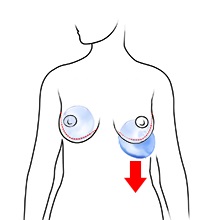
Breast implant surgery involves the placement of a suitable implant in your breast to improve or correct its aesthetic appearance. It aims to enhance the appearance of your breasts by giving them the desired shape, size, firmness, and symmetry.
A breast explant surgery involves the removal of a previously placed breast implant for medical or aesthetic reasons.
Each surgery is performed by a plastic or cosmetic surgeon.
What are the Indications for a Breast Implant Surgery?
Breast implant surgery is recommended to improve the appearance of your breasts. You are a good candidate for breast implant surgery if you have:
- Inadequate breast development
- Sagging breasts due to breastfeeding, pregnancy, or developmental defect
- Changes in breast shape or appearance due to weight gain, weight loss, or ageing
- Asymmetrical breasts
It can also be performed if you are:
- A breast cancer survivor and had a previous mastectomy or breast removal surgery
- Have undergone a previous breast surgery and want to change the implant
What are the Indications for a Breast Explant Surgery?
Breast explant surgery is recommended if you want to remove your existing implant for the following reasons:
- To replace it with another better-fitting or type of implant
- To remove it due to complications such as:
- Capsular contracture (hardening of the breast)
- Pain from implants
- Leakage from implant components
- If you simply wish to discontinue implants
Pre-Surgical Preparation for Breast Implant/Explant Surgery
Pre-surgical preparation for a breast implant or explant surgery includes the following:
- A thorough examination by your surgeon to check for any medical issues that need to be addressed before surgery.
- You may be required to obtain a mammogram to help detect any breast abnormalities.
- Refrain from taking anti-inflammatory drugs, blood thinners, or aspirin as they may increase the risk of bleeding during your surgery.
- Avoid smoking and alcohol consumption before and after your surgery for a specified period of time, as this may hamper proper healing and increase your chances of areolar or nipple damage, tissue necrosis, and other complications.
- You will also be given instructions related to diet and lifestyle changes to ensure a successful surgery.
- The site of the breast incision is marked and the appropriate size of the implant is determined by taking your breast measurements.
- The type of implant - either silicone or saline - is also determined before the procedure.
Procedure for Breast Implant and Breast Explant Surgery
Both breast implant and breast explant surgery can be performed either in an outpatient or hospital setting. You are placed on the operating table on your back in the supine position. The choice of anaesthesia is decided by the surgeon based on the candidate’s age, health, and medical history.
Procedure: Breast Implant Surgery
The basic steps for a breast implant surgery are:
- Your surgeon will make an incision following one of these approaches:
- Inframammary: Along the crease under your breast; it is the most common approach
- Axillary: Under your arm or beneath your armpit
- Periareolar: Around your nipple
- After making the incision, your surgeon creates a pocket either behind or in front of the pectoral muscle (outermost muscle of the chest wall) to place the implant. This is done by separating your breast tissue from the muscles and connective tissue of your chest.
- The implant is inserted into the pocket and placed centrally behind your nipple.
- After the implant has been placed properly, the incision is sutured (stitched) and covered with a bandage and surgical tape.
Procedure: Breast Explant Surgery
The general procedure for a breast explant surgery is outlined below:
- Your surgeon will make the incision along the marked skin surface. It could be along the inframammary fold or it could be below or around the areola.
- After making the incision, your surgeon accesses the implant in the chest pocket by separating the breast tissue from the muscles and connective tissues in your chest.
- The breast capsule and implant are removed from the chest pocket.
- The breast and nipple are positioned for correct shape and symmetry.
- Finally, your surgeon closes the incision and covers it with a bandage and surgical tape.
Recovery and Post-Surgical Care for Breast Implant and Explant Surgery
Most people can go home within a couple of days after the surgery if no complications are noted.
- You may notice sensitivity, tenderness, swelling, and bruising over the operated breast. Pain and anti-inflammatory medications are provided as needed.
- Your surgeon may provide you with antibiotics to reduce the risk of infection.
- Refrain from any physical activity for 2 to 4 weeks to promote healing.
- Avoid heavy lifting or any strenuous activities as you recover.
- You are recommended to wear a supportive bra for at least 2 days post-procedure.
- Your surgeon will provide you with instructions on diet, wound care, and bathing.
- You may need to take time off from work for at least a week.
- You will be able to resume normal activities within a couple of weeks but may have certain activity restrictions.
A periodic follow-up will be scheduled to monitor your overall progress.
What are the Risks and Complications of Breast Implant and Explant Surgery?
As with any surgical procedure, breast implant or explant surgery may also involve certain risks and complications such as the following:
- Risk of implant or gel migration
- Areola distortion
- Scarring
- Necrosis or tissue death
- Loss of sensation in the breasts or nipples
- Infection
- Formation of blood clots
